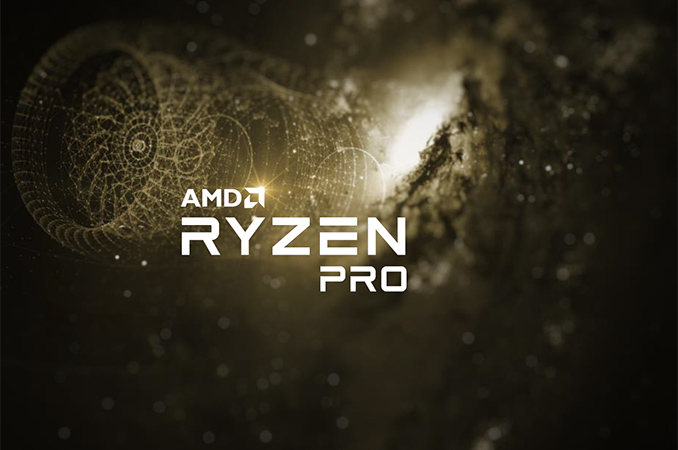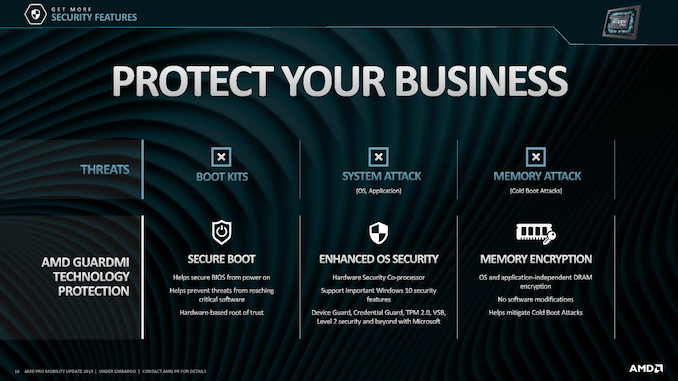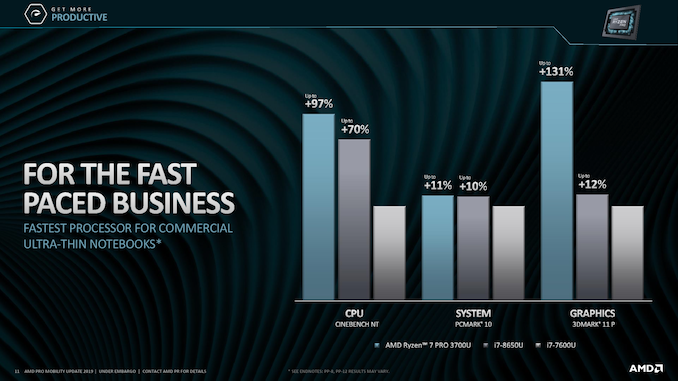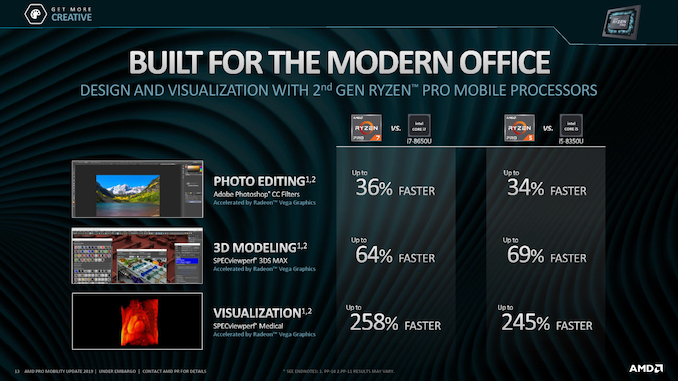AMD Launches 2nd Gen Ryzen Pro & Athlon Pro APUs
by Anton Shilov on April 9, 2019 9:15 AM EST
AMD on Monday introduced four new processors aimed at commercial laptops. The new AMD Ryzen Pro 3000-series as well as AMD Athlon Pro 300-series processors pack up to four x86 cores as well as AMD’s Radeon Vega integrated graphics. Because of improved power efficiency, AMD says that laptops powered by its latest Ryzen Pro APUs will work for up to 12 hours when used for general office workloads.
AMD’s new Pro-series processors are essentially the Ryzen Mobile 3000-series APUs and made using GlobalFoundries’ 12LP process technology. The parts have numerous features supported by AMD’s Pro-series products, such as a built-in TrustZone security processor, DASH manageability, Secure Boot, Content Protection, per-Application security, fTPM 2.0, Transparent Secure Memory Encryption (TSME), and some other technologies are they key feature which differentiate AMD’s Pro from the company’s regular processors for client PCs.
Furthermore, AMD uses wafers with highest yields/least amount of defective parts to build the Ryzen Pro in a bid to meet long term reliability. These CPUs are covered by a 36-month limited warranty, up from 12-month warranty for consumer processors. AMD also guarantees that its Pro-series products will be available for at least 24 months after initial launch and also provides 18 months of planned software stability.
The family of AMD’s 2nd generation Ryzen Pro Mobile processors includes four models: the Ryzen 7 Pro 3700U, the Ryzen 5 Pro 3500U, the Ryzen 3 Pro 3300U, and the Athlon Pro 300U. The Ryzen Pro-branded parts feature four cores with or without SMT, whereas the Athlon Pro device has two cores. All of the APUs have an integrated Radeon Vega GPU, yet with a different configuration. The new APUs feature a TDP of up to 15 W and are therefore aimed at ultra-portable laptops.
| AMD's 2nd Gen Ryzen Pro Specifications | |||||||
| Cores Threads |
Frequency | Cache L2 + L3 |
GPU | TDP | |||
| Base | Boost | ||||||
| Ryzen 7 Pro 3700U | 4/8 | 2.3 GHz | 4.0 GHz | 6 MB | Vega 10 | 15 W | |
| Ryzen 5 Pro 3500U | 2.1 GHz | 3.7 GHz | Vega 8 | ||||
| Ryzen 3 Pro 3300U | 4/4 | 2.1 GHz | 3.5 GHz | Vega 6 | |||
| Athlon Pro 300U | 2/4 | 2.4 GHz | 3.3 GHz | 5 MB | Vega 3 | ||
When compared to AMD’s 1st generation Ryzen Pro Mobile parts, the Ryzen 7 Pro 3700U and the Ryzen 5 Pro 3500U offer slightly higher base as well as turbo clocks. By contrast, the Ryzen 3 Pro 3300U features a lower base frequency, yet a slightly higher turbo frequency, when compared to the Ryzen 3 Pro 2300U.
(For those interested, it should be noted that the Athlon Pro 300U is a full 12nm chip, built on the Zen+ Picasso design, whereas the non-Pro version is a 14nm chip, and a second iteration of Raven Ridge.)
AMD’s own tests show that its Ryzen 7 Pro 3700U is ~1% better than the 8650U in PCMark and up to double in performance when graphics comes into the mix.
Obviously, GPU-intensive workloads are the ones where AMD’s APUs outshine Intel’s CPUs. Meanwhile, general-purpose performane of AMD's and Intel's processors for commercial laptops is very close, according to AMD.
AMD has already started to ship its Ryzen Pro 3000-series and Athlon Pro 300-series processors to its partners among PC makers. HP and Lenovo are expected to be the first to offer commercial laptops based on the new APUs. Other manufacturers are projected to follow later in 2019.
Related Reading
- HP Unveils ProDesk 405 G4 Desktop Mini PC: An SFF Ryzen Pro Desktop
- Two New 35W Raven Ridge Parts: AMD Athlon 200GE and Athlon Pro 200GE
- AMD Launches Ryzen Pro with Vega: Mobile APUs and Desktop APUs
- AMD Launches Ryzen PRO CPUs: Enhanced Security, Longer Warranty, Better Quality
Source: AMD




















40 Comments
View All Comments
BigMamaInHouse - Tuesday, April 9, 2019 - link
Cinebench R15: Core i7-8565U vs. Ryzen™ 7 3700U: 619 vs. 688!IGTrading - Wednesday, April 10, 2019 - link
Wonderful piece of technology.I love that the day has come when you can truly recommend AMD over Intel for an overwhelming number of scenarios and applications.
No reason to buy Intel anymore, unless there is some specific code where Intel's arch behaves better and you care not about all the other benefits AMD brings.
eastcoast_pete - Tuesday, April 9, 2019 - link
One aspect that might hurt AMD here is that any prospective buyer of Ryzen Pro systems knows that better-performing 7 nm Ryzen chips are coming soon. So, in a perverse way, Intel's laziness or incompetence in moving below 14 nm works in their favor, especially with business customers: there is little risk that they will make substantial improvements in the next 12 months, so you might as well buy now.SaberKOG91 - Tuesday, April 9, 2019 - link
It all depends on when you need it and what you are buying. Most companies refresh at least a fraction of their machines every year, with very few companies replacing all machine every couple of years. As the 2XXX series systems get retired from the channel, they will get replaced by 3XXX and that will be all you can buy until next spring when 7nm Ryzen Mobile is available. There's no reason to wait on for 7nm if you need to buy laptops this year. Desktops and workstations are another story though.neblogai - Tuesday, April 9, 2019 - link
That depends on AMD's ambition. If they desired, they could bring a high-performance 7nm 8core CPU to mobiles this year, by creating a special, low power I/O die (with basic graphics/VPU as well), and coupling it with 7nm Zen2 chiplet. That chiplet would probably not be able to powergate as well as a chip designed specifically for mobile, but at 7nm, and with low power I/O, that should still be enough for high performance laptops to have decent idle battery life.SaberKOG91 - Tuesday, April 9, 2019 - link
Very unlikely. They will be maximizing 7nm throughput for server and desktop parts that bring in all the money. Even if they had production capacity, it still wouldn't make sense. We are way too early in the design cycle for the 4XXX series parts to be even a consideration. Expect Q4 announcements with full launch early next year. With the delay going on with desktop 3XXX and Navi, there's not even remotely a chance of 7nm mobile this year. Also you are forgetting that mobile packages need to be small for wide adoption. It makes no economical sense to add an I/O die for a single CPU die, even with graphics in the mix.neblogai - Tuesday, April 9, 2019 - link
Sorry- I don't get any of your arguments.1) AMD has almost no presence in high performance/gaming laptops. It takes time to build up presence there. It would take negligible number of 7nm capacity for AMD to start that entrance.
2) Naming is the least of the issues for a company- only users make big deal out of it. These mobile chips could be mobile 3xxx H-series R7 or R9 without any problem.
3) There is no date set for 7nm monolithic APUs, only several year old slide indicates it should come in late 2019. And it also indicates that it would be power efficient 10-35W 4-core only designs, not high performance parts.
4) There is no delay with 3xxx or Navi. 3xxx was promissed to come out mid-2019- and we will be getting 3xxx and Navi announcements 27th of May.
5) AMD needs a mobile I/O die if they 8-core for want mobile and embedded markets. Packaging 2 chips together is certainly not an issue (Intel packages 3 chips for Kaby Lake-G). Investment from AMD would not be big, because most of the mobile I/O design elements could be reused from RR and from Matisse I/O. It's all on 14nm. So, it only depends on AMD's ambition, if they try to expand into high-performance mobile and embedded, or not.
SaberKOG91 - Tuesday, April 9, 2019 - link
1) You seriously underestimate the cost of small runs, especially on a new process node.2) I was referring to naming because that's likely what they will be called next year, not because AMD couldn't release a faster chip under the current branding.
3) I am estimating based on what we have seen in the past for rolling out to new nodes. AMD has almost always launched the mobile parts on a new node and microarchitecture after their desktop counterparts.
4) A few different sources have stated that there was an issue in Fall of 2018 that held back the 3XXX parts from being released earlier in 2019 to mirror the launch of the 2XXX parts. It wasn't until after that that AMD came out and officially started saying later in 2019. One would assume Navi may have been impacted as well.
5) False. They would simply go with a larger monolithic package. The cost of integrating multiple chiplets onto a single package for what would be a < 300mm^2 die makes no sense. Interposers are expensive and add height to the package. Spacing of the chiplets makes the package larger in area. Both of which are tradeoffs that make no sense for mobile designs. Intel uses EMIB which allows them to do this without an interposer which means shorter packages. AMD have no publicly announced corresponding IP. I forget where Papermaster answered a question about this, but AMD have already indicated that they would not be using chipsets for this generation of mobile and desktop APUs.
SaberKOG91 - Tuesday, April 9, 2019 - link
Edit: chiplets, not chipsets*neblogai - Wednesday, April 10, 2019 - link
1) Old 14nm process for I/O die, while half the silicon is aleady done in Zen2 chiplet. So releasing it would be cheap, and proper use of chiplet architecture to expand addressable market.2) Not doing in now is a waste of opportunity.
3) Does not have to be later this time, because Zen2 chiplet is done, while I/O chiplet does not need any new tech, only a copy of what they have already done.
4) Rumours, and no leaks of actual schedule.
5) No interposer or EMIB needed, and no need for new Zen2 chiplet- only new 14nm I/O die, and mounting the two dies together on FP5. AMD said Matisse (AM4 package) will not have GPU die chiplets, that is all. And it makes sense, because Matisse is for desktop, and that would be unnecessary and expensive- same as making a monolithic powerful 7nm mobile APU, while Zen2 chiplet is already there waiting.